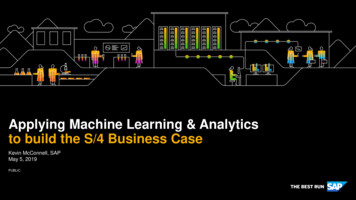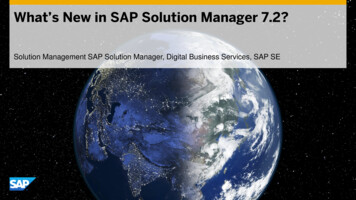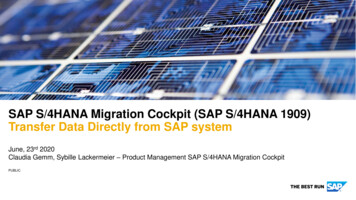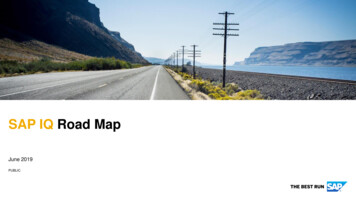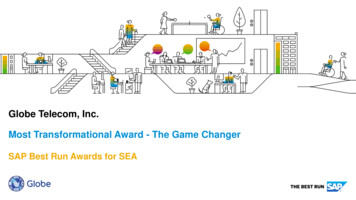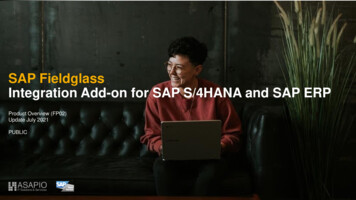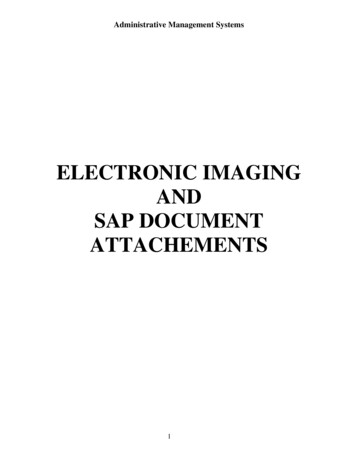
Transcription
Administrative Management SystemsELECTRONIC IMAGINGANDSAP DOCUMENTATTACHEMENTS1
Table of ContentsIntroduction3Scanning / Linking Supporting Documents To SAP TransactionDocumentsPre-requisites4Scanning “hard” copies of (supporting) documents:4Linking a Scanned/Electronic Document to Your SAP Document:5Displaying Linked/Attached Documents6-7Appendix A: Technical Start-up – What’s Required:Technical Set-up for document scanning8Technical Set-up or document viewing82
IntroductionTraditionally, most supporting documents for posted SAP transaction documents have beenstored in paper format in files. Subsequently, departmental and/or non-departmental staff haveneeded to access these back-up documents for a variety of reasons. Unfortunately, this has oftenbeen anything but a quick or efficient task, even when successful. Storing the information onlineas scanned/”desk-top” attachments to the SAP documents they support, not only facilitates theretrieval process, but also “virtually” eliminates the lost time, frustration, and evenembarrassment, of not being able to locate those inevitable missing paper documents.While some of our AMS users have already begun utilizing electronic access to scanned/linkedback-up images attached to their posted SAP documents, the document imaging and linkingfunctionalities already available within SAP provide any authorized user with the opportunity totake similar advantage of this convenience.Although we cannot as yet dispose of the paper copy of the supporting document even after it hasbeen electronically linked to the SAP document, this online storage and retrieval functionality isstill a more efficient and reliable process than dealing with the physical copies alone. Pleaseclick here to obtain the University of Toronto Policy and Guideline for Imaging of FinancialDocuments.At this time, most users will be able to access the following supporting documents throughtheir posted SAP transactions: AP and PO-related Vendor invoicesDebit memo authorizationsPST exemptionsBack-up lettersExpense ReimbursementsWord documentsSpreadsheetsAppendix A: Technical Start-up – What’s Required:3
Scanning / Linking Supporting Documents ToSAP Transaction DocumentsPre-requisites:1)The necessary technical requirements have been set-up (see Appendix A:Document Scanning and Linking Technical Start-up – What’s Required; AppendixB: Document Viewer Installation/Upgrade Guide); and2)Internal procedures have been established within your area in order to incorporate thecreation and maintenance of electronic records as part of the “usual and ordinary course ofbusiness”, for example:*******what original documents are to be scannedwhere will they be scanned to (i.e.: local directories)by whomwhat SAP transaction documents will they be linked towhen will this take place relative to the original document scanningwho will link the documentswhat identification (i.e.: name, number) will be used to cross-reference the originalpaper document, the SAP transaction document, and the scanned (electronic) document.Scanning “hard” copies of (supporting) documents:1. Scan the supporting documents, select correct profile, rotate if necessary, ensure legibility,etc. Note: The SAP transaction document number should continue to be clearly writtenonto applicable supporting documents, (i.e.: vendor invoices), before scanningNote: The “colour” option on your scanner should never be selected when scanningdocuments. This is not only because colour imaging is not necessary to the function of astored/linked document, but primarily because activating the option on the scanner would,(even if scanning an original which is not in colour), greatly increase the amount of storagespace used up.2. Make sure document images match originals3. Name and save the file, in appropriate file format (i.e.: “TIF”; “PDF”)4
Linking a Scanned/Electronic Document to Your SAP Document:1. Access the posted SAP document, (i.e.: invoice, debit memo, etc), in either change ordisplay mode2. Click on the “list” (as circled in the example below) portion of the “Services for object”(document link) icon.3. Click on “Create” and then on “Store business document”NOTE: Always select “Store business document” when attaching a document to a SAPdocument. “Create Attachment” must not be selected or the attached supportingdocument will not be saved/”archived” in the document imaging system, but rather itwould be saved directly in the SAP database, thereby using up valuable system resources.4. Double click on the appropriate “Document Type” (i.e.: “Vendor Invoices” in either“TIF” or “PDF” formats for scanned documents, or “Supporting Documents” in either“DOC” or “XLS” formats for stored files, etc.)5. Use the pop-up box “search” function to find and select the desired scanned/stored filename. Double click on the file name (or select it and click on the “Open” button).6. Click on the “Continue/Enter” icon.The supporting document is now linked to the SAP document.5
Displaying Linked/Attached Documents:1. Access the posted SAP document in either change or display mode2. Click on the “list” (as circled in the example below) portion of the “Services for object”(document link) icon.3. Click on “Attachment List”6
4. Double click on the linked document to be viewed7
Appendix A: Technical Start-up – What’sRequired:Technical Set-up for document scanning:Any good quality scanner (i.e.: providing easily legible image quality/resolution “of asource document that can be used to generate an intelligible reproduction of thatdocument”*) An additional consideration would be scanning speed, if large volumescanning is required.NOTE: The “colour” option on your scanner should never be selected when scanningdocuments. This is not only because colour imaging is not necessary to the function of astored/linked document, but primarily because activating the option on the scannerwould, (even if scanning an original which is not in colour), greatly increase the amountof storage space used up.Technical Set-up for document viewing:In order for Livelink to work properly, SAPGUI 6.20, Adobe Acrobat Reader 6.x or higherand OpenText Livelink components must first be installed.See instructions at * In the case of a paper source document, an intelligible reproduction means that:the reproduction is made with the intention of standing in place of the source documentthe interpretation of the reproduction, for the purposes of which it is being used, gives thesame information as the source document;the limitations of the reproduction (e.g., resolution, tone or hues) are well definedand do not obscure significant details.(The Canadian General Standards Board – General Requirements for Books and Records –Revised June 2005 – Canada Revenue Agency)Note: Until the University is certified, paper documents cannotbe destroyed.8
* when will this take place relative to the original document scanning * who will link the documents * what identification (i.e.: name, number) will be used to cross-reference the original paper document, the SAP transaction document, and the scanned (electronic) document. Scanning "hard" copies of (supporting) documents: 1.


